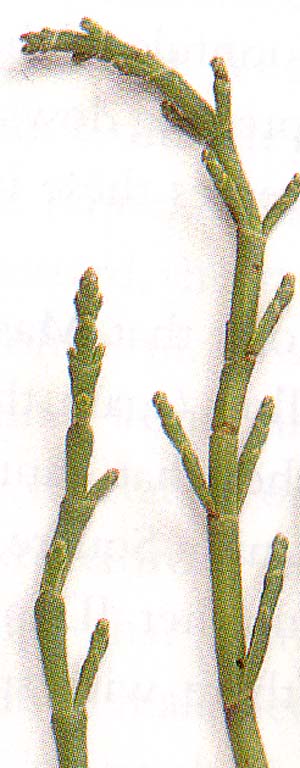
| What is Flavor and Fortune? |
| How do I subscribe? |
| How do I get past issues? |
| How do I advertise? |
| How do I contact the editor? |
Read 12914659 times
Connect me to:
| Home |
| Articles |
| Book reviews |
| Letters to the Editor |
| Newmans News and Notes |
| Recipes |
| Restaurant reviews |
| Article Index (all years, slow) |
| List of Article Years |
| Article Index (2025) |
| Article Index (last 2 years) |
| Things others say |
| Related Links |
| Log In... |
| Authors |
| Categories & Topics |
Sea Asparagus
| by Jacqueline M. Newman |
Vegetables and Vegetarian Foods
Spring Volume: 2007 Issue: 14(1) page(s): 13 and 31

 Ever purchase a vegetable that looked like asparagus with branches that smelled as if it came from the sea? Cooked, did it taste a mite salty with no asparagus taste? You probably bought a green emerald-colored veggie that no one seems able to give the same name as anyone else. This delightful not very well-known green is also known as sea beans, sea fennel, samphire, marsh samphire, glasswort, and at least a dozen other monikers including grass-land green skinny razor clams.
Ever purchase a vegetable that looked like asparagus with branches that smelled as if it came from the sea? Cooked, did it taste a mite salty with no asparagus taste? You probably bought a green emerald-colored veggie that no one seems able to give the same name as anyone else. This delightful not very well-known green is also known as sea beans, sea fennel, samphire, marsh samphire, glasswort, and at least a dozen other monikers including grass-land green skinny razor clams.
Now grown and growing popular in coastal regions of China, Mexico, Hawaii, and Canada, this delicious vegetable can really be one of two plants, both native to England's shoreline and other places such as at the Brittany coastline in France, parts of the Mediterranean, coastal areas in Australia, and throughout most of Asia.
These two related species may be one reason for its multiple names. They look alike, both commonly eaten raw, pickled, or cooked. Botanically, one is Salicornia europaea, the other Orithmum maritimum. The former is a relative of beets and its brethren, the latter a member of the Umbelliferae family as are carrots, celery, and fennel, to name but a few.
When we first ate them in a Chinese restaurant in Asia where we began to learn their many names. It was not early spring, and on that occasion they came in a can. In early summer they are fresh, local, and hard to find. Off-season, they can be fresh but more than likely will be canned or maybe cultivated. On the occasion of our first encounter, we did ask to see them uncooked. They arrived on a tray and in a can that said they were a product of Malaysia. The name on that tin called it 'sea asparagus.' The manager of the hotel's Chinese restaurant called them 'glasswort.'
Researching them a some days later when we return home, we learn they were the alkali used to manufacture what was called 'soda glass.' Rarely are they used for that purpose nowadays. We learn these two plants with their many names grow in salty marshland and often on cliffs near the seaside. We also find out they are now cultivated and available year-round. We learn to cook them as one does asparagus. Some folk dip them in boiling water first to reduce their salty taste. These are succulent young shoots whose leaves we have never seen. We are told they can be handled similarly. Both plant varieties are used raw or blanched as well as pickled, and cooked, as already indicated.
They are not a sea weed, though some sources do so mislabel them. While similar to a succulent, they are not on eof those either. They snap when broken, are just a tad salty, and certainly need refrigeration to remain crisp. For those who have trouble locating them fresh or in tins but do know a recipe or two, such as the one below, some sources say to substitute snow peas, melting mouth peas, or asparagus when they are unavailable.
Chinese chefs prefer to use their shoots young. When older they can get woody. Some also like to barely cook them. Others cook them for five or more minutes. We are told they have a resinous aroma when raw that disappears when cooked two minutes or more. These halophilous plants go well with chicken, fish, and other vegetables, and they are good in soups and stews.
Besides the leaves and stems, their seeds are used as is, or they are processed to extract their oil. This last use was more common years ago but is less so today. Recently, we saw some reddish sea asparagus and wondered what relative that was. A knowledgeable merchant told us those this color are commonly found in the fall. It is then they turn reddish and soon thereafter, die back.
Rare or red, or green and common, look for them. They are available where specialty produce is sold. Learn more about them. Check them out on web sites using one of their various names. One merchant at Misty Mountain calls them 'salicornia tips.' Others more often call them sea beans or glasswort. In and out of season, do enjoy them pickled. Purchase them fresh in early summer, their price less exorbitant then. Purveyors tell us they are not common in the Chinese culinary, several did not know the Chinese even used them; but they do.
One Chinese chef told us he likes to cook them with eggplant. He calls this dish: Land and Sea Asparagus. He breaks the vegetables into two-inch pieces and cuts a thin eggplant in pieces of similar size. He fries a bit of garlic and ginger in a tablespoon of soy oil and adds half-inch wedges of a small onion and a dash of white pepper. These he fries for a minute, puts in the eggplant pieces and stir-fries them for two to three minutes. He adds a good splash of Chinese rice wine and the sea asparagus and a few tablespoons of a good stock and simmers this mixture for five minutes, then serves them.
Below is the only printed Chinese recipe we located for this vegetable. Try his or this one or make up your own. You can use this vegetable in any Chinese stir-fried dish or in any soup or stew. Learn to love them as we now do.
| Sea Asparagus with Chicken |
|---|
1 Tablespoon vegetable oil 1 clove garlic, peeled and minced 1 slice peeled fresh ginger, minced 1/2 pound boneless chicken thighs, cut into two-inch pieces 2 Tablespoons Chinese rice wine 1/4 cup cold chicken broth mixed with two tablespoons of cornstarch pound sea asparagus, blanched half minute in boiling water 1/4 teaspoon dry mustard mixed with one teaspoon cold water 1 cup cilantro leaves, minced Preparation: 1. Heat wok or pan, add oil and then the garlic and ginger pieces and stir-fry for half minute before adding the chicken pieces. Brown, stirring them for a minute then add rice wine and stir for one minute. 2. Cover the wok and cook for two minutes, add sea asparagus and recover and cook for two more minutes. 3. Add chicken broth mixture and the mustard mixture and stir-fry one minute. Stir in the cilantro, then serve. |

Copyright © 1994-2025 by ISACC, all rights reserved
Address
3 Jefferson Ferry Drive
S. Setauket NY 11720